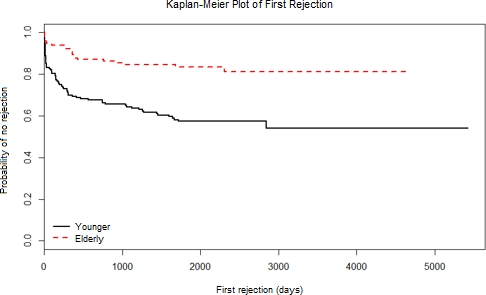Long-Term Outcomes of Graft Function in Elderly Kidney Transplant Recipients
Henry Ford Transplant Institute, Detroit, MI.
Meeting: 2018 American Transplant Congress
Abstract number: D192
Keywords: Elderly patients, Graft function, Outcome, Rejection
Session Information
Session Name: Poster Session D: Kidney: Acute Cellular Rejection
Session Type: Poster Session
Date: Tuesday, June 5, 2018
Session Time: 6:00pm-7:00pm
 Presentation Time: 6:00pm-7:00pm
Presentation Time: 6:00pm-7:00pm
Location: Hall 4EF
Purpose: To compare and evaluate 5-year outcomes of graft function for younger (Y) versus elderly (E) kidney transplant recipients (KTR).
Introduction: As the number of elderly KTR increases, differences between this population and younger are unknown.
Methods: A single-center retrospective analysis of medical records of 318 first-time KTR from 2003-10 on mycophenolate, tacrolimus, and steroid regimen was performed. The study population was divided into two cohorts: (Y: ≤59 yrs; n=172; E: ≥65 yrs; n=146). KTR aged 60-64 were excluded to distinguish groups. Baseline characteristics, first biopsy-proven acute rejection (BPAR), estimated glomerular filtration rates (eGFR) at discharge and annually up to 5 yrs were analyzed. BPAR were graded using Banff schema (≥2A = severe). Time to BPAR was demonstrated using Kaplan-Meier plots (KM) and reliability was tested using a multivariate Cox proportional-hazards model and log-rank test.
Results: There was no statistical difference between demographics, induction therapy, maintenance immunotherapy, type of transplant, immediate graft function, BMI, length of stay, or median follow-up days [Y, 2132 (1770, 2729); E, 2048 (1540, 2538); p>0.05]. There was no difference in eGFR at yrs 0-5 (p>0.05). BPAR is described in table 1. KM exhibit less and earlier BPAR among E [0.376 (0.23, 0.615), p<0.001]. The log rank tests indicate time to BPAR are indeed different in Y and E (p<0.001).
| Younger n=172 (%) | Elderly n=146 (%) | p-value | ||
| BPAR | Yes | 70 (40.7) | 23(15.8) | <0.001 |
| Severity | Mild | 54 (31.4) | 16 (11) | |
| Severe | 16 (9.3) | 7 (4.8) | ||
| IGF | 110 (64) | 103 (70.5) | p>0.05 | |
Conclusions: Elderly KTR experience less rejection in incidence and severity. These patients also maintain excellent long-term graft function that is comparable to younger KTR.
CITATION INFORMATION: Bajjoka I., Yaldo A., Crombez C., Abouljoud M. Long-Term Outcomes of Graft Function in Elderly Kidney Transplant Recipients Am J Transplant. 2017;17 (suppl 3).
To cite this abstract in AMA style:
Bajjoka I, Yaldo A, Crombez C, Abouljoud M. Long-Term Outcomes of Graft Function in Elderly Kidney Transplant Recipients [abstract]. https://atcmeetingabstracts.com/abstract/long-term-outcomes-of-graft-function-in-elderly-kidney-transplant-recipients/. Accessed January 5, 2026.« Back to 2018 American Transplant Congress


